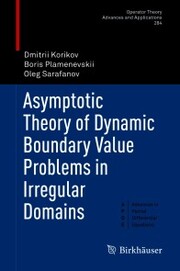Detailansicht
Asymptotic Theory of Dynamic Boundary Value Problems in Irregular Domains
eBook - Operator Theory: Advances and Applications
ISBN/EAN: 9783030653729
Umbreit-Nr.: 1864606
Sprache:
Englisch
Umfang: 0 S., 5.51 MB
Format in cm:
Einband:
Keine Angabe
Erschienen am 01.04.2021
Auflage: 1/2021
E-Book
Format: PDF
DRM: Digitales Wasserzeichen
- Zusatztext
- <p>This book considers dynamic boundary value problems in domains with singularities of two types. The first type consists of "edges" of various dimensions on the boundary; in particular, polygons, cones, lenses, polyhedra are domains of this type. Singularities of the second type are "singularly perturbed edges" such as smoothed corners and edges and small holes. A domain with singularities of such type depends on a small parameter, whereas the boundary of the limit domain (as the parameter tends to zero) has usual edges, i.e. singularities of the first type. In the transition from the limit domain to the perturbed one, the boundary near a conical point or an edge becomes smooth, isolated singular points become small cavities, and so on.<br><br> In an "irregular" domain with such singularities, problems of elastodynamics, electrodynamics and some other dynamic problems are discussed. The purpose is to describe the asymptotics of solutions near singularities of the boundary.&nbsp;<br><br> The presented results and methods have a wide range of applications in mathematical physics and engineering. The book is addressed to specialists in mathematical physics, partial differential equations, and asymptotic methods.</p><p></p>
- Kurztext
- This book considers dynamic boundary value problems in domains with singularities of two types. The first type consists of &quote;edges&quote; of various dimensions on the boundary; in particular, polygons, cones, lenses, polyhedra are domains of this type. Singularities of the second type are &quote;singularly perturbed edges&quote; such as smoothed corners and edges and small holes. A domain with singularities of such type depends on a small parameter, whereas the boundary of the limit domain (as the parameter tends to zero) has usual edges, i.e. singularities of the first type. In the transition from the limit domain to the perturbed one, the boundary near a conical point or an edge becomes smooth, isolated singular points become small cavities, and so on. In an &quote;irregular&quote; domain with such singularities, problems of elastodynamics, electrodynamics and some other dynamic problems are discussed. The purpose is to describe the asymptotics of solutions near singularities of the boundary.&nbsp; The presented results and methods have a wide range of applications in mathematical physics and engineering. The book is addressed to specialists in mathematical physics, partial differential equations, and asymptotic methods.
